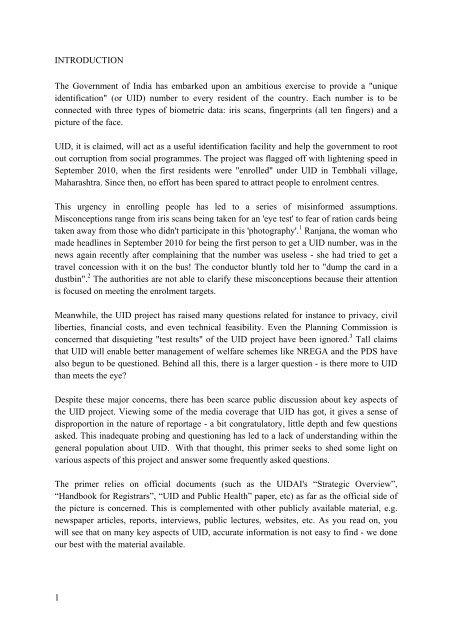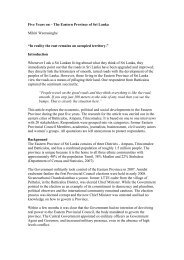UID For Dummies (PDF) - Countercurrents.org
UID For Dummies (PDF) - Countercurrents.org
UID For Dummies (PDF) - Countercurrents.org
Create successful ePaper yourself
Turn your PDF publications into a flip-book with our unique Google optimized e-Paper software.
INTRODUCTION<br />
The Government of India has embarked upon an ambitious exercise to provide a "unique<br />
identification" (or <strong>UID</strong>) number to every resident of the country. Each number is to be<br />
connected with three types of biometric data: iris scans, fingerprints (all ten fingers) and a<br />
picture of the face.<br />
<strong>UID</strong>, it is claimed, will act as a useful identification facility and help the government to root<br />
out corruption from social programmes. The project was flagged off with lightening speed in<br />
September 2010, when the first residents were "enrolled" under <strong>UID</strong> in Tembhali village,<br />
Maharashtra. Since then, no effort has been spared to attract people to enrolment centres.<br />
This urgency in enrolling people has led to a series of misinformed assumptions.<br />
Misconceptions range from iris scans being taken for an 'eye test' to fear of ration cards being<br />
taken away from those who didn't participate in this 'photography'. 1 Ranjana, the woman who<br />
made headlines in September 2010 for being the first person to get a <strong>UID</strong> number, was in the<br />
news again recently after complaining that the number was useless - she had tried to get a<br />
travel concession with it on the bus! The conductor bluntly told her to "dump the card in a<br />
dustbin". 2 The authorities are not able to clarify these misconceptions because their attention<br />
is focused on meeting the enrolment targets.<br />
Meanwhile, the <strong>UID</strong> project has raised many questions related for instance to privacy, civil<br />
liberties, financial costs, and even technical feasibility. Even the Planning Commission is<br />
concerned that disquieting "test results" of the <strong>UID</strong> project have been ignored. 3 Tall claims<br />
that <strong>UID</strong> will enable better management of welfare schemes like NREGA and the PDS have<br />
also begun to be questioned. Behind all this, there is a larger question - is there more to <strong>UID</strong><br />
than meets the eye?<br />
Despite these major concerns, there has been scarce public discussion about key aspects of<br />
the <strong>UID</strong> project. Viewing some of the media coverage that <strong>UID</strong> has got, it gives a sense of<br />
disproportion in the nature of reportage - a bit congratulatory, little depth and few questions<br />
asked. This inadequate probing and questioning has led to a lack of understanding within the<br />
general population about <strong>UID</strong>. With that thought, this primer seeks to shed some light on<br />
various aspects of this project and answer some frequently asked questions.<br />
The primer relies on official documents (such as the <strong>UID</strong>AI's “Strategic Overview”,<br />
“Handbook for Registrars”, “<strong>UID</strong> and Public Health” paper, etc) as far as the official side of<br />
the picture is concerned. This is complemented with other publicly available material, e.g.<br />
newspaper articles, reports, interviews, public lectures, websites, etc. As you read on, you<br />
will see that on many key aspects of <strong>UID</strong>, accurate information is not easy to find - we done<br />
our best with the material available.<br />
1










